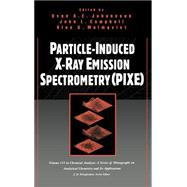Particle-Induced X-Ray Emission Spectrometry (PIXE)
, by Johansson, Sven A. E.; Campbell, John L.; Malmqvist, Klas G.; Winefordner, James D.- ISBN: 9780471589440 | 0471589446
- Cover: Hardcover
- Copyright: 8/18/1995
Long proven as an analytical tool of uncommon accuracy and utility, particle-induced X-ray emission has enjoyed a solid, if narrow, reputation in the area of chemical analysis. Capable of detecting elemental concentrations down to parts per million, PIXE is now a standard component of the analytical arsenal of the nuclear physics laboratory. Yet in wider avenues of chemical research, PIXE technology is still relatively new and untested. An inside look at the nuts and bolts of PIXE from specialists who've refined the technique in biomedicine, atmospheric science, geology, and art and archaeology, this comprehensive introduction to PIXE reveals its conceptual foundation and unique methodology as well as its, as yet, enormous untapped potential as a primary analytical tool. Particle-Induced X-Ray Emission Spectrometry (PIXE) offers professionals and students a practical, user-based look at the many facets and current uses of PIXE for multielemental analysis while providing a stimulus for creative, insightful investigation. Beginning with a brief history of PIXE, the book then introduces the reader to the conceptual basics central to understanding and using PIXE. It details the hardware and methodology that make up PIXE, examining its instrumentation, characteristics of x-ray spectroscopy, standardization of quantitative analysis, the accuracy of PIXE analysis, and its limits of detection. The technique of focusing proton beams to micron dimensions with the nuclear microprobe is thoroughly detailed, with practical advice on what pitfalls to avoid, and clear illustrations of its present uses in biomedicine, materials science, archaeology, and earth science. The following chapters form a comprehensive catalog of the cutting-edge uses of PIXE in a host of fields, shedding light on the technical specifics unique to each area of research as well as the intrinsic versatility of PIXE. A discussion of biological and medical applications includes a look at sample preparation, micro- and macro-PIXE, the use of PIXE with other methods, and data evaluation. PIXE's role in the compositional analysis of atmospheric aerosols is described, including a look at PIXE's future impact on global climate research. A look at PIXE's applications in the earth sciences contrasts the analysis of bulk material with grains and crystallites and highlights PIXE's practical uses in key areas of geologic research. PIXE's role in art and archaeology includes a fascinating and detailed exposition of its important role in the analysis of gem stones, pottery, paper-like materials, and pigments and paintings. Concluding with a detailed comparative analysis of PIXE with other current analytical methods, the book then provides a fascinating glimpse into the future prospects of PIXE. A must reference for the professional and novice in search of the basic hardware and methods behind the current state of the science, Particle-Induced X-Ray Emission Spectrometry (PIXE) is a premier guide to exploring the analytical possibilities open to this unique technology. The authoritative handbook to exploiting the full power and versatility of PIXE- now and in the next century Respected for its practical accuracy and detection range of parts per million, particle-induced X-ray emission has enjoyed a secure place in the analytical arsenal of the nuclear physics laboratory. Yet, its undeniable analytical potential in other areas of science has scarcely been tapped. This unique reference, from PIXE specialists in biomedicine, atmospheric science, earth science, and art and archaeology, features a user-based look at PIXE's conceptual basics and methodology, with a view toward new and creative analytical work. Touching on every facet of PIXE technology, from basic instrumentation, specimens, the characteristics of X-ray spectroscopy, standardization of quantitative analysis, to the accuracy of PIXE analysis and its limits of detection, the book offers an u







